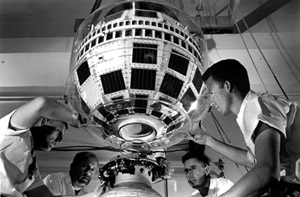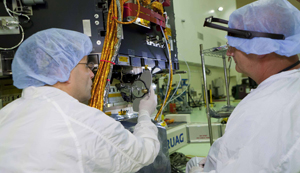July 9, 2012 In the Loop: Looking Back at Telstar, Looking Ahead to RBSP On Tuesday, July 10, 2012, at the former Bell Labs campus in Murray Hill, NJ (now operated by Alcatel-Lucent), the 50th anniversary of the launch of the Telstar satellite will be celebrated with a series of speakers who will discuss Telstar’s groundbreaking achievements and legacy today.  The first Telstar satellite (shown here during assembly) was launched on July 10, 1962, 50 years ago this month. It was seriously damaged by massive influxes of radiation – some of it natural, from the Van Allen radiation belts. Credit: Alcatel-Lucent/Bell Labs One of those speakers is Louis Lanzerotti, who came to Bell Labs in 1965 to work on data analysis from those early communications satellites. “I went to Bell Labs because of Telstar,” says Lanzarotti, who serves today as distinguished professor of physics in the Center for Solar-Terrestrial Research at the New Jersey Institute of Technology. Lanzerotti is also Principal Investigator for the Radiation Belt Storm Probes Ion Composition Experiment (RBSPICE), one of the instruments on NASA’s RBSP mission. For Lanzerotti, investigating the radiation belts with state-of-the-art instruments flying within the belts themselves – and asking new questions about the fundamental processes of the belts – is a research opportunity that harkens back to his early work on the belts at the dawn of the Space Age. “RBSP is ‘back to the future’ for me,” says Lanzerotti, “because it’s my last mission, and it’s studying the same things I started out working on.”  Members of the RBSP team test the RBSPICE instrument on spacecraft A. RBSP will answer fundamental questions about the processes that occur within the radiation belts. Credit: JHU/APL The July 10, 1962 launch of Telstar I – a yard-wide, 170-pound communication satellite that carried innovations such as transistors and solar panels, and could carry 600 voice calls and one television channel (black and white only) – marked the dawn of the modern telecommunications age. Telstar I carried the first transatlantic television signal, among many other firsts. It proved the concept of satellite communications was feasible, and set the stage for the tremendous capacities of today’s systems. Unfortunately, Telstar I only operated for approximately eight months in its low-Earth orbit before it was seriously damaged by massive influxes of radiation – some natural, from the Van Allen radiation belts, and some manmade, from atmospheric nuclear testing. The Bell Labs team that built launched the pioneering Telstar satellite did not have a clear picture of the space environment above our planet. The researchers that proposed and pushed the development of telecommunications satellites like Telstar “had no reason to believe there was anything of concern in the space environment,” Lanzerotti says. “Everyone thought [the area] was relatively benign.” Fifty years later, researchers like Lanzerotti and others on the RBSP team and in heliophysics understand much more about the hazards posed by highly charged particles in the radiation belts – though the processes that drive and shape the belts are still not fully understood. Those mysteries are the focus of the RBSP mission: Modern society’s dependence on satellites and other spaced-based technologies that must operate in the belts makes the research that will come from RBSP’s data valuable to building better-protected satellites in the future. “We know a lot more now about the space environment and space weather,” says Lanzerotti, “and RBSP will be a major step forward in quantifying and eventually predicting conditions.” To learn more about the marking of the 50th anniversary of Telstar’s launch, visit http://www.alcatel-lucent.com/events/2012/telstar/. The Radiation Belt Storm Probes mission is part of NASA’s Living With a Star program, which is managed by Goddard Space Flight Center in Greenbelt, Md. The Johns Hopkins University Applied Physics Laboratory (APL) in Laurel, Md., manages the mission and is building and will operate the RBSP spacecraft for NASA. |

